Cat-amarans, Ships, and Cats
Did you know: “Catamaran” is derived from the Italian ‘gatta marina’, and is a vessel that always lands on its feet in high seas.
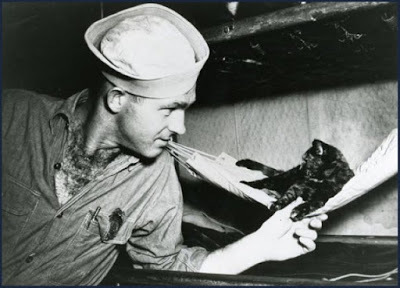
The modern ship the catamaran is just one example of how cats are linked strongly to the sea. In the days of sailing ships, a cat was considered the guardian spirit of the ship. In theory the cat might have been there to catch vermin, but in reality sailors believed that the feline protected the ship and crew from misfortune.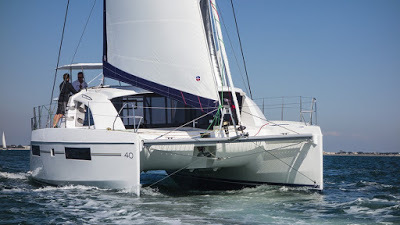
There are folklore stories of sailors who refused to set sail on a ship because there was no cat on board. Indeed, up until 1975 it was mandatory for a British role Royal Navy to have ship’s cat.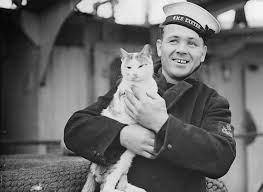 Pincher, ship's cat and mascot for HMS Exeter
Pincher, ship's cat and mascot for HMS Exeter
Another indication of the importance of cats to a ship was what happened when a ship was in peril. If a ship was abandoned and the cat went too, then the vessel was considered derelict and was forfeit to the Admiralty or King. However, if the cat remained on board under adverse conditions, the ship was protected from confiscation.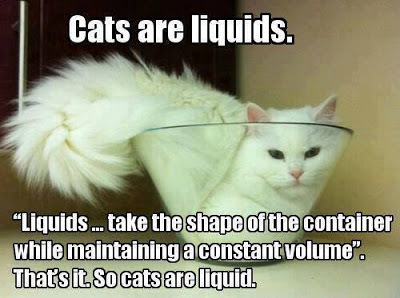
Calling vessels “She” may be a throwback to the ancient Egyptian goddess Isis. She was the patroness of nature, family, and magic – indeed her reputation made it as far as pagan Britain in her divine incarnation as a cat. It seems pagan worship of Isis, then cats with their feminine associations, ensured the vessel took on the female pronoun.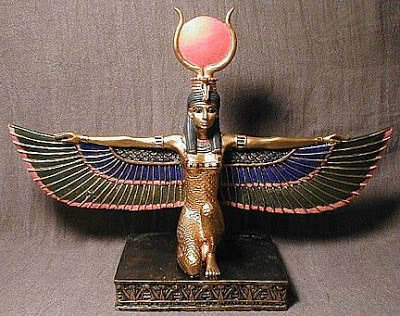 Statuette of the Egyptian goddess Isis
Statuette of the Egyptian goddess Isis

The modern ship the catamaran is just one example of how cats are linked strongly to the sea. In the days of sailing ships, a cat was considered the guardian spirit of the ship. In theory the cat might have been there to catch vermin, but in reality sailors believed that the feline protected the ship and crew from misfortune.

There are folklore stories of sailors who refused to set sail on a ship because there was no cat on board. Indeed, up until 1975 it was mandatory for a British role Royal Navy to have ship’s cat.
 Pincher, ship's cat and mascot for HMS Exeter
Pincher, ship's cat and mascot for HMS ExeterAnother indication of the importance of cats to a ship was what happened when a ship was in peril. If a ship was abandoned and the cat went too, then the vessel was considered derelict and was forfeit to the Admiralty or King. However, if the cat remained on board under adverse conditions, the ship was protected from confiscation.

Calling vessels “She” may be a throwback to the ancient Egyptian goddess Isis. She was the patroness of nature, family, and magic – indeed her reputation made it as far as pagan Britain in her divine incarnation as a cat. It seems pagan worship of Isis, then cats with their feminine associations, ensured the vessel took on the female pronoun.
 Statuette of the Egyptian goddess Isis
Statuette of the Egyptian goddess Isis
Published on May 29, 2016 11:06
No comments have been added yet.
'Familiar Felines.'
Following on from last weeks Halloween posting, today's blog post looks at the unwanted image of cats as the witches familiar - from the Norse Goddess Freya to lonely women in the middle ages.
The full Following on from last weeks Halloween posting, today's blog post looks at the unwanted image of cats as the witches familiar - from the Norse Goddess Freya to lonely women in the middle ages.
The full post can found at:
http://graceelliot-author.blogspot.com
...more
The full Following on from last weeks Halloween posting, today's blog post looks at the unwanted image of cats as the witches familiar - from the Norse Goddess Freya to lonely women in the middle ages.
The full post can found at:
http://graceelliot-author.blogspot.com
...more
- Grace Elliot's profile
- 156 followers



